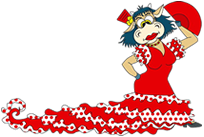Manuel Aranda Zamorano, well known as "Talegón de Córdoba", born in 1944 in the Santa Marina neighborhood, in Cordoba.
Orphan very young and he moved to Madrid, he worked for the tablaos environment, he learned a lot of the great masters.
He started singing very young with the folk songs, helped by his aunt "La Talegota". He performed in the Duques de Rivas Theater and the Gran Teatro in Cordoba.
Now she sings for the company Blanca del Rey in Madrid, singing classes.
-
-
Manuel de los Santo Gallardo, also known as the "Agujeta el Viejo", born ni Jerez de la Frontera (Cadiz) in 1908 and died in Rota (Cadiz) in 1976. Profession blacksmith, he received the name of "Agujeta" when he was working in the railways, changing the points (agujas) in the routes.
Agujetas el Viejo got married in Rota with the gypsy Ana Pastor Monje, they had 4 girls and 5 boys. The older, Tomasa, then Juana, Angélica and Maria. For the boys we have Manuel Agujetas, Luis Agujetas, Juan el Gordo, Paco and Diego.
His brothers were Carmen de lso Santos Gallardos, mother of Miguel Pastor de los Santos (Gitanillo de Bronce), Diego "Rubichi", Domingo and "El Chalao".
He'll never become a professional, but he was an inspiration for his sons, grandchild and nephews. We have very little records of his songs. -
Manuel de los Santos Pastor, also known artistically as "Agujeta de Jerez", born in Jerez in 1946, in the Calle Acebuche. When he's 1 year the family moved ti Rota, and he came back to Jerez with 15 years old. At 17 he has to do his military duty in the air force.
His beginning as a singer was listening to his father, the great "Agujeta el Viejo" when they were working the forge.
With 8 years old he was singing in bars to win some money, but also was working with his father. Once, "Parrilla el Vieja" invited him to a song, and "Agujera de Jerez" answered :"I said that I was going to improve my life, so I begin to sing".
He also worked as a welder master, he was great at shearing beasts and sheeps, well known from Puerto de Santa Maria to the surrounding area of Sevilla.
An artist of "cante jondo", seguiriyas and soleares. His discography is made up of 19 discs.
His father was the follower of the Manuel Torre school. He continued with the most ancient and old-fashion flamenco form. in 1970, in Madird, he recorded his first disc, accompanied by Manolo Sanlucar and his guitar. In 1977 he's been awarded with a prize: the "Premio Nacional de Cante de la Cátedra de Flamencología de Jerez". He worked with Carlos Saura in the movie "Flamenco" (1994). Agujetas en Paría (Harmonia Mundi, 1996), Agujeta en la soleá (Alia, 1998, under teh labelled Palo Nuevo). He recorded "24 kilates" by seguiriyas, soleares and fandangos.
The French Dominique Abel produced a documentary "Agujetas cantaor" in 2000.
Then he lived a few years between Mexico and the United States.
He also offered shows in Paris, London, New York, not onlyin Spain. In 1977 he received the award "Premio Nacional de la Cátedra de Flamencología de Jerez". He is the son of an oral tradition that will probably die with him.
Agujetas lives in a house that he is constantly reconstructing. He plants vineyards, he picks tea (tea from Tokyio, his wife is from Tokyo, she is a very special dancer, different. None one gypsy woman can dance like she does.).
Manuel is pure essence. -
Miguel Vargas Jiménez, also known as "Bambino", born in 1940 February 12. in Utrera, province of Sevilla, in the Calle Nueva, a neighborhood of gypsies and died in Utrera in 1999 May 5.
Son of Manuel Vargas Torres "Chamona", barber, and Francisca Jiménez Ramírez "Frasquita", cantaora and bailaora, but performing only for her family, sister of Manuel "De Angustias".
Miguel's father wanted him to work as a barber, a secure profession. He wanted to become a football player, he played as a central defender. A whole life passion.
His other passion was singing, something very natural for him, his mother and brother "Chamona" were singers.
In 1957 May 15. the gypsies of Utrera decide to celebrate an anual gypsy gathering.
Each family brought what they can, somthing to drink or to eat to share and to celebrate this special day. For the inauguration some artists were present, like "Diego el de la Gloria", "Bernarda", "Pepa", "Perrate", "Manuel", "Gaspar de Utrera", and "Fernanda". "Diego el de Gloria" performed a version of "Bambino Piccolino" by Renato Carasone. From this night he received the name of "El Bambino".
His cousin Juan el Lebrijano took him to the tablao "La Venta de Antequera", where the "Gitanillo de Triana" realized that Miguel had great abilitie to sing and he hired him for "El Duende", in Madrid, tablao owned by Pastora Imperio.
In 1963 the bullfighter "Gitanillo de Triana" took him to Madrid, to the tablao "El Duende". After that he sung in Pasapoga, in Las Cuevas, in Los Canasteros with Caracol, in Torres Bermejas with LA Paquera and Faíco. In the 60s and 70s Bambino had a lot of fans. Places like Zar, Morocco, Florida Park or Mayte Commodore in Madrid; and Tabú, Las Vegas or El Bombín in Barcelona, witnesses of his best moments on stages. Thanks to the bullfighter "Gitamillo de Triana" he also performed in tablaos like Real Venta de Antequera in Sevilla and El Duende in Madrid. He was the King if the Rumba. His reperoire included very flamenco coplas, boleros and rancheras.
In 1961 he already was singing in the Venta Real de Antequera in Sevilla. Bambino recorded 500 songs. His first disc was recorded with 24 years old with Philips, including the famous "El poeta lloró": He also worked for the tablao "Torres Bermejas" with La Paquera de Jerez and the dance "Faico".
He died at his sister's home in el Tinte, neighborhood of Utrera, because of a larynx cancer, in 1999 May 5.












